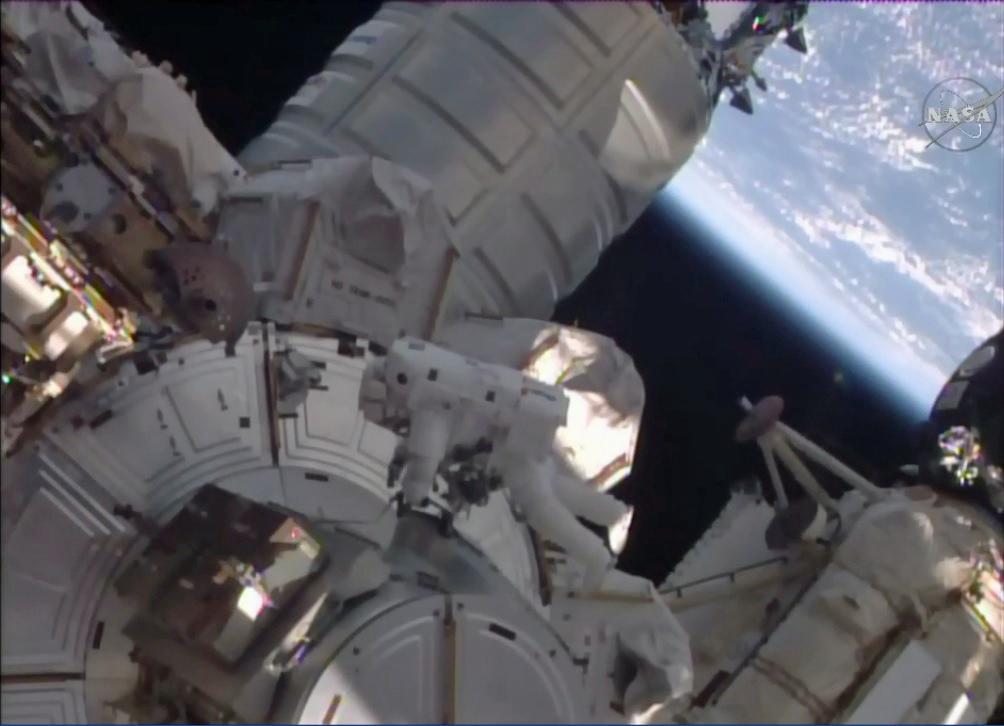Spacewalking Astronauts Rescue Stuck Space Station Railcar

Two astronauts took a surprise spacewalk outside the International Space Station this morning (Dec. 21) to unstick a vital piece of equipment and lock it into place before a resupply spacecraft arrives.
The station's mobile transporter railcar got stuck just 4 inches (10 centimeters) from where it could be safely latched down Wednesday night (Dec. 16). The railcar must be secured before the Progress resupply spacecraft, which launched early this morning, arrives at the station, bringing 2.8 tons (2.5 metric tons) of food and supplies. The railcar acts as the home base of the station's Canadarm2 robotic arm.
The spacewalk was put together in "just a few days," after the railcar got stuck, NASA spokesman Rob Navias said during NASA's live broadcast of the operation. [Gallery: Most Memorable Spacewalks of History]
NASA astronaut Scott Kelly commanded the spacewalk, his third, and NASA astronaut Tim Kopra joined him outside. Kopra arrived at the space station less than a week ago; this is the second spacewalk of his career. British astronaut Tim Peake, who also recently arrived, assisted the astronauts in getting out and back into the station. (He also helped by taking a photo of Kelly through the windows of the space station's cupola.)
After an early start at 7:45 a.m. EST (1245 GMT), the astronauts were able to free the railcar — they released a stuck brake handle — and complete the task in just 35 minutes before moving on to several "get-ahead" tasks that will be useful for future activity on the station. Once the railcar was freed, it could be remotely directed those last few inches to lock into place.
For the remainder of the spacewalk, the duo tackled several tasks, including rerouting an Ethernet cable for use in a future Russian science module and putting down cables for future international docking adaptors that will let commercial spacecraft attach to the station.
The tasks proceeded quickly over the course of the spacewalk, which lasted just 3 hours and 16 minutes, but the duo still had time to admire the view:
Breaking space news, the latest updates on rocket launches, skywatching events and more!
"How's the Earth look?" astronaut Mike Hopkins asked the pair from Ground Control in Houston.
"Beautiful — it's dark," they responded. "Taking pictures."
"You should be passing over India right now," Hopkins added.
After the spacewalk ended, spokesman Navias deemed the process "quickly planned and executed to perfection."
The Progress 62 supply craft launched from the Baikonur Cosmodrome in Kazakhstan this morning at 3:44 a.m. EST (0844 GMT) and is en route to the station; it will rendezvous with the station autonomously two days from now. The craft brings supplies and research tools for the crewmembers currently aboard the station: Kelly, Kopra and Peake, as well as cosmonaut Yuri Malenchenko, who arrived last Tuesday (Dec. 15) with Kopra and Peake; cosmonaut Mikhail Kornienko, who has been on board for nine months with Kelly as part of a yearlong space mission; and cosmonaut Sergey Volkov.
Another spacewalk is planned for mid-January to replace a voltage regulator that failed several weeks ago, taking down one of the station's eight power channels, NASA officials said. Preparations for that spacewalk will begin tomorrow.
Email Sarah Lewin at slewin@space.com or follow her @SarahExplains. Follow us @Spacedotcom, Facebook and Google+. Original article on Space.com.

Sarah Lewin started writing for Space.com in June of 2015 as a Staff Writer and became Associate Editor in 2019 . Her work has been featured by Scientific American, IEEE Spectrum, Quanta Magazine, Wired, The Scientist, Science Friday and WGBH's Inside NOVA. Sarah has an MA from NYU's Science, Health and Environmental Reporting Program and an AB in mathematics from Brown University. When not writing, reading or thinking about space, Sarah enjoys musical theatre and mathematical papercraft. She is currently Assistant News Editor at Scientific American. You can follow her on Twitter @SarahExplains.
